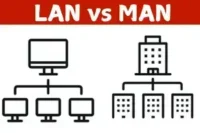What is LAN to LAN and LAN to WAN?
Published: February 7, 2025
Have you ever wondered why LAN-to-LAN and LAN-to-WAN connections are so different, even though they both involve networking? It’s easy to assume they function similarly, but understanding the differences between local and wide area network connections is crucial for choosing the right one for your needs. How do these two connections compare, and why does it matter?

LAN to LAN
A LAN-to-LAN connection refers to linking two or more Local Area Networks (LANs) within a limited area, like a single building or campus. This type of connection is often used when different locations or offices within the same organization need to share data or resources.
1. How it works
LANs can be connected either physically using Ethernet cables or wirelessly via Wi-Fi.
You can use a VPN (Virtual Private Network) to connect distant LANs securely over the Internet.
2. Use cases
- Connecting multiple offices or buildings of the same organization.
- Sharing resources like printers, files, or databases between different LANs.
3. Advantages
Speed
Communication between devices in LAN to LAN is typically faster since the network is local (limited to a smaller area).
Low Latency
The connection doesn’t have to travel far, so the response time is quick.
Efficiency
Since LANs are nearby, sharing resources like printers, servers, and databases is easy.
4. Limitations
Distance
LAN-to-LAN connections are generally limited by the network’s physical distance (within a building or campus).
Infrastructure
Setting up multiple LANs requires the proper physical or wireless infrastructure.
LAN to WAN
A LAN-to-WAN connection involves linking a Local Area Network (LAN) to a Wide Area Network (WAN). WANs can cover large distances, such as connecting to the Internet or a larger corporate network spread across cities or countries.
1. How it works
Devices in the LAN connect to the WAN via a router and modem (for home networks) or specialized hardware (for corporate networks).
The Internet or other remote resources are accessed through the WAN, which enables connection to services and applications that aren’t on the local network.
2. Use cases
Internet Access
Connecting a home or office network to the Internet.
Remote Work
Accessing work files, applications, or servers from a remote location.
Cloud Services
Connecting to cloud storage, SaaS applications, and other online services.
3. Advantages
Global Connectivity
It allows access to internet-based services and remote networks, enabling worldwide communication.
Resource Access
It allows access to a vast amount of information and applications hosted on the Internet or in the cloud.
4. Limitations
Speed and Latency
WANs (especially the Internet) can be slower than LAN-to-LAN connections. The speed depends on your internet connection type (fiber, DSL, satellite) and the distance data has to travel.
Complexity
Setting up LAN to WAN requires more infrastructure and a reliable internet service provider (ISP).
Key Differences between LAN to LAN and LAN to WAN
1. Distance
LAN to LAN: Local connections (within a building or campus).
LAN to WAN: Remote connections (connects to the Internet or remote networks).
2. Speed
LAN to LAN: Faster speeds, as the communication occurs over shorter distances.
LAN to WAN: Speed can vary due to external factors like internet service quality and distance.
3. Security
LAN to LAN: Easier to secure because the network is contained within a small, controlled environment.
LAN to WAN: The network connects to external public networks, which poses more security risks and requires additional protections like firewalls, encryption, and VPNs.
When to Use Each
LAN to LAN
- This method is best for sharing resources between locations within a small geographical area (e.g., within an office building or a campus).
- Ideal for low-latency, high-speed communication.
LAN to WAN
- Essential for connecting to the Internet or accessing remote servers and resources.
- It is necessary for businesses that require access to cloud-based tools or remote workers.
You May Also Like These Posts
Conclusion
LAN-to-LAN connections are perfect for local communication, focusing on speed and resource sharing in a small area.
LAN-to-WAN connections are designed to extend your local network’s capabilities to access global resources, such as the Internet, but they come with the challenges of managing security and variable speeds.
FAQs About LAN to LAN and LAN to WAN
LAN to LAN connects two or more local networks within a limited area (like an office or building). LAN to WAN, conversely, connects a local network to a broader network like the Internet or a remote network, allowing global access.
A LAN-to-LAN connection is ideal for sharing resources, such as files or printers, between devices within the exact location or nearby offices. It’s great for local communication, where speed and low latency are essential.
LAN to WAN provides access to remote resources and the Internet. It allows you to access cloud-based services, work remotely, and connect to external databases or applications.
No, LAN-to-LAN is typically used for local networking within a building or campus. For remote work, a LAN-to-WAN connection is required to connect to the Internet and access resources outside of the local network.
Since LAN-to-WAN connections extend your network to the Internet, they can be vulnerable to attacks like hacking or data breaches. Securing these connections with firewalls, encryption, and VPNs is essential.
Speed can be improved by using higher-speed internet connections, such as fiber optics, and optimizing the configuration of routers and network equipment. Reducing congestion and ensuring proper network management can also help.
A VPN (Virtual Private Network) allows secure communication between two LANs, even if they are geographically far apart. It extends the local network over the Internet, making remote LANs appear as if they are on the same local network.
Yes, a single router can manage both types of connections. LAN to WAN connects the local network to the Internet, and LAN to LAN can link multiple local networks within a building or campus.
Yes, LAN-to-WAN setups typically require more configuration, including choosing an internet service provider (ISP), setting up routers and modems, and ensuring proper security measures. LAN-to-LAN setups are simpler and usually only require linking local devices.
If your LAN to WAN connection is slow, check your internet speed, upgrade hardware like routers or modems, and optimize settings for the connection. Ensuring your connection is not overloaded with too many devices or high-bandwidth activities can also improve speed.





